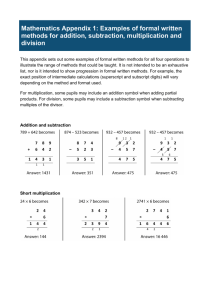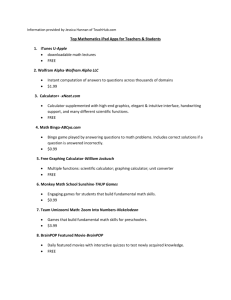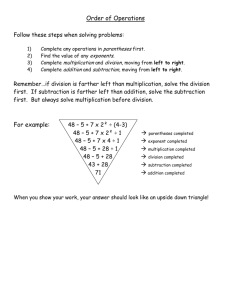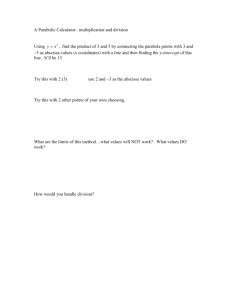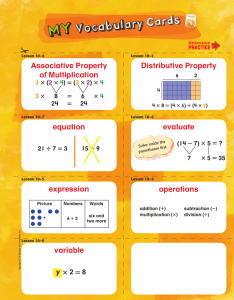Math Trailblazers Homework Help
advertisement
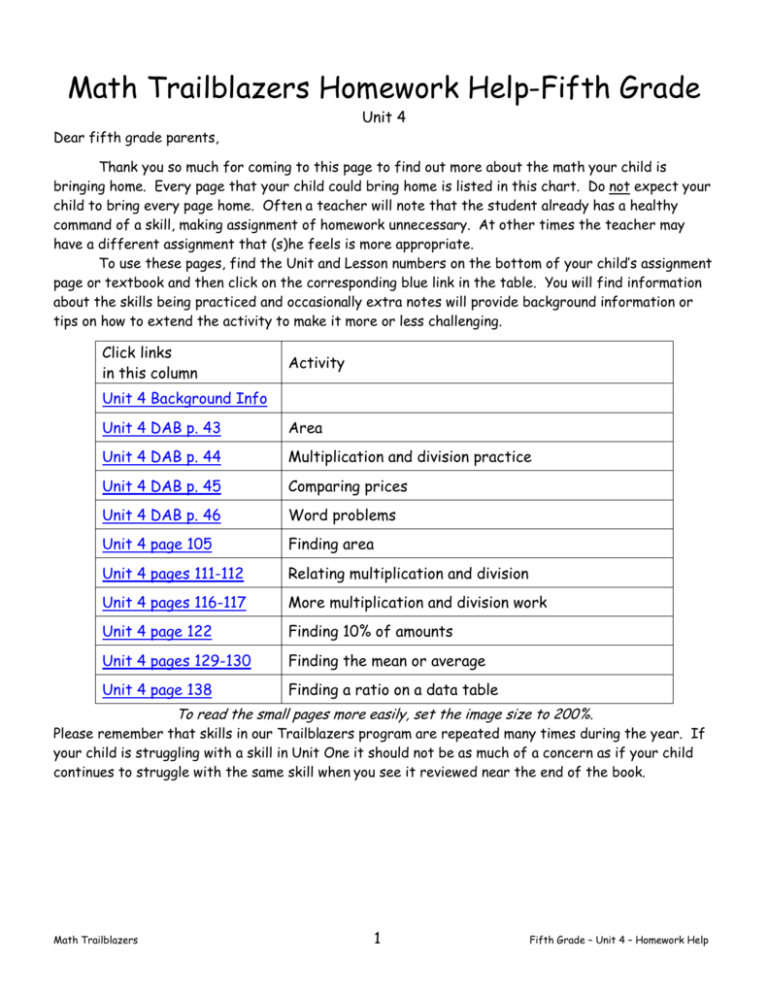
Math Trailblazers Homework Help-Fifth Grade Unit 4 Dear fifth grade parents, Thank you so much for coming to this page to find out more about the math your child is bringing home. Every page that your child could bring home is listed in this chart. Do not expect your child to bring every page home. Often a teacher will note that the student already has a healthy command of a skill, making assignment of homework unnecessary. At other times the teacher may have a different assignment that (s)he feels is more appropriate. To use these pages, find the Unit and Lesson numbers on the bottom of your child’s assignment page or textbook and then click on the corresponding blue link in the table. You will find information about the skills being practiced and occasionally extra notes will provide background information or tips on how to extend the activity to make it more or less challenging. Click links in this column Activity Unit 4 Background Info Unit 4 DAB p. 43 Area Unit 4 DAB p. 44 Multiplication and division practice Unit 4 DAB p. 45 Comparing prices Unit 4 DAB p. 46 Word problems Unit 4 page 105 Finding area Unit 4 pages 111-112 Relating multiplication and division Unit 4 pages 116-117 More multiplication and division work Unit 4 page 122 Finding 10% of amounts Unit 4 pages 129-130 Finding the mean or average Unit 4 page 138 Finding a ratio on a data table To read the small pages more easily, set the image size to 200%. Please remember that skills in our Trailblazers program are repeated many times during the year. If your child is struggling with a skill in Unit One it should not be as much of a concern as if your child continues to struggle with the same skill when you see it reviewed near the end of the book. Math Trailblazers 1 Fifth Grade – Unit 4 – Homework Help Back to index Unit 4 Background Information The main emphasis of this unit is whole number division. Children have done division using models since kindergarten. They were introduced to the Forgiving Division algorithm in grade four but some of them may not remember the procedure. Forgiving Division This pattern allows children to choose numbers that are easy for them 266 . to multiply. In the example at the right, the child knew that 4 x 100 4 ) 1064 . was 400 and used that fact twice. 400 100. Next the child reasoned that if four 100s made 400, four 50s would be 664 . half as much or 200. The partial quotients are placed to the right of 400 100. the vertical line and then added together and written above the bridge 264 . (division symbol). 200 50. This method of division is explained using different numbers on student 64 . guide pages 113-115 40 10. 24 . 24 6. 0 . Math Trailblazers 2 Fifth Grade – Unit 4 – Homework Help Back to index Area: Most of these area problems are pretty straight forward but 4B is a little tricky. Since 12 x 8 = 96 the first thought is that 96 is less than 100 and the run should fit. What if the yard is 10 x 10 to make the 100 square feet? Will a 12 foot run fit? Back to index Multiplication and Division Practice: In fourth grade, students learned the forgiving division algorithm. Click here for a review of the forgiving division pattern. Math Trailblazers 3 Fifth Grade – Unit 4 – Homework Help Back to index Comparing Prices: Students have been making point graphs with best-fit lines since the end of third grade so the graphing part of this task should be something they can reasonably accomplish independently. Ratios were introduced in the previous unit and will be a newer concept. The ratio of cost to number for Sharpy Pencils is 20 cents to 2 pencils. One way to show the cost is on the graph. Start at 4 pencils, go up to the best fit line and then go across to 40 cents. Another way is with equivalent ratios 2 = 4 20 40 Back to index Word Problems: One of the most important aspects of this page is that different problems use different combinations of operations. This is the way adults encounter problems in real life. If you child is struggling, help the child try to understand the action in the situation. Relate the action to the operations table listed below. Put together Take apart Individual items Addition Subtraction Equal size groups Multiplication Division Additionally, comparisons are made using subtraction. Math Trailblazers 4 Fifth Grade – Unit 4 – Homework Help Back to index Unit 4 Page 105 Q 1. Shapes A and C can be completed easily by counting squares. A possible equation (number sentence for shape A could be (1x4)+(1x4)=8 cm2. Another view could be (1x2)+(2x2)+(1x2)=8 cm2. Shape B be can be done by inference. Image a rectangle that goes behind the left end of shape C. Find the area of the rectangle and divide that area by two to determine the area of the triangle. Place the grid paper over shape D or measure the sides using a ruler to determine the area. Q 2 This can be any shape. It can be checked by counting the squares inside.. Q 3. If the child makes a 2X7 rectangle and then draws a shape with part of the line outside the rectangle and approximately the same area inside the square, this task will be accomplished. Q 4 This could be a 3x7 rectangle but other shapes will also work such as a rectangle that is 3½ x 6. Q 5 The easiest way might be to draw a rectangle with an area of 12 sq. cm and then cutting it in half from corner to corner. Q 6 An “L” shaped hexagon might work well for this but there are many other possible shapes that will work. Math Trailblazers Back to index Unit 4 Page 111-112 Q 1 through 4 Base ten shorthand for 144÷3 looks like this. From this, you can probably decide on the other answers. Q 5 and 6 Encourage your child to identify how the significant digits remain the same as the number of zeros changes. Q 7 This shows how multiplication and division are related to each other. Q 8 and 9 The remainders for question 8 could be arranged in a variety of ways. Question 9 will not have a remainder. Q 10 Since the number is being divided by four and the remainder is .25 or ¼ then ¼ of four has to be one. Q 11 If your child is struggling with these calculations, figure the result with the zeros covered and then see how the answer changes when the zeros are included. Q 12 through 15 These are more division calculations embedded in story settings. 5 Fifth Grade – Unit 4 – Homework Help Back to index Unit 4 Page 116-117 Q 1 through 3 These questions show the relationship between multiplication and division. Combining amounts to get a larger total means multiplication. Sorting into smaller, equal size groups involved division. Q 4 through 9 Click here for a review of the forgiving method of division. Q 10 A story for Q 4 might be… “The choco company had 586 candy bars come off the assembly line in one hour. If four different machines are making candy bars at about the same speed, how many bars came from each machine?” Q 11 through 17 These are problems involving all four operations. Children may solve them in any manner they feel is best for them. If they decide to use a calculator have the children tell you, using estimates, why the number on the calculator is reasonable. Q 18 through 20. Calculate in any method except the use of a calculator. Since the object of these tasks is to calculate, then a calculator is not appropriate. Back to index Unit 4 Pages 129-130 Q 1 through 6 This book uses the word average to describe methods for finding numbers in the middle of a set. It identifies mean, median and mode as different averages. That is why question 2 says “Use the mean” to describe the average. Q 7 through 22 Be sure to remember to use order of operations with these equations. Multiplication and division are done before addition and subtraction. The correct answer for number seven is 12 because 3x3=6 plus 6 more makes 12. Eighteen is not correct because that requires adding to be done before the multiplying. Also remember that all numbers within parentheses are completed before the other four operations. Number eighteen is the same as 9x3 because the addition and subtraction inside the parentheses is done before the multiplication which is outside of them. Back to index Unit 4 Page 138 Q 1 through 3 Students have explored this area of water on paper towels in fourth and fifth grade. The new idea this year is to express the area to drops comparison as a ratio. In this case, the area to drops ratio is 2 to 1. Children have been doing best fit lines and point graphs since third grade and should be familiar with their construction. Back to index Unit 4 Page 122 Q 1 through 8 These tasks all work with 10% or multiples of 10%. The easiest way to find 10% is to just cover the last digit of the number. For example, 10% of 5,282 is about 528. One error students often make is finding 10% of the estimate instead of 10% of the original. Math Trailblazers 6 Fifth Grade – Unit 4 – Homework Help


